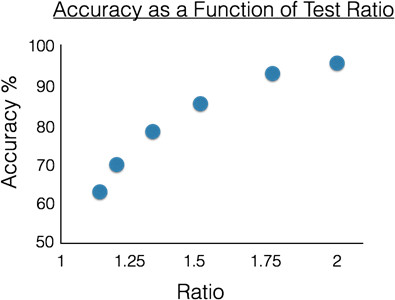대략적인 숫자 감지 테스트
Overview
출처: 조나단 플롬바움 연구소 -존스 홉킨스 대학
일반적인 카니발 게임은 항아리에 포장 된 젤리빈의 수를 추측하는 사람들에게 요청하는 것입니다. 누구든지 정확한 숫자를 올바르게 얻을 가능성이 낮습니다. 그러나 누군가가 17 또는 147,000을 추측 할 가능성은 어떻습니까? 아마도 정답을 추측 할 수있는 기회보다 훨씬 적습니다. 17과 147,000은 비이성적인 것처럼 보입니다. 왜? 결국, 콩을 꺼내서 한 번에 하나씩 계산할 수 없다면, 누군가가 추정치가 너무 높거나 너무 낮다는 것을 어떻게 알 수 있습니까?
그것은 구두 계산 에 추가 (뭔가 명확 하 게 배운), 사람들이 숫자를 추정 하기 위한 하드 와이어 정신 및 신경 메커니즘을 가지고 나타납니다. 구어체로 말하자면, 그것은 추측 할 수있는 능력, 또는 "야구장"이라고 할 수 있습니다. 실험 심리학자들은 그것을 "대략적인 숫자 감각"이라고 부르며, 같은 이름의 실험 패러다임이있는 최근 연구는 추측 할 수있는 능력을 지원하는 기본 계산 및 신경 메커니즘을 밝히기 시작했습니다.
이 비디오는 대략적인 숫자 감지 테스트를 통해 비언어적 수치 추정을 조사하기 위한 표준 절차를 보여줍니다.
Procedure
1. 자극과 시험
- Psychopy, MATLAB 또는 유사한 것(www.panamath.org 비상업적 용도로도 무료 버전을 다운로드할 수 있음)에서실험을 프로그래밍합니다.
- 실험의 모든 시험을 설계하여 더 많거나 적게 동일하게 보입니다.
- 디스플레이를 반으로 나눕니다. 회색 배경을 사용합니다.
- 디스플레이의 한쪽에는 파란색 원 컬렉션이 표시됩니다.
- 다른 쪽은 노란색 원의 컬렉션을 보여줍니다.
- 샘플 예심(도1)에도시된 바와 같이 다른 크기로 원을 그립니다.

그림 1. 대략적인 숫자 감지 테스트의 단일 시험의 회로도 묘사. 각 시험에서 참가자는 더 많은 파
Results
Application and Summary
사람들은 대략적인 숫자 감각의 시력 면에서 상당히 서로 다릅니다. 개인 간의 차이를 특성화하기 위해 실험 심리학자는 일반적으로 사람이 75 %의 정확도로 구별 할 수있는 가장 작은 비율을 찾기 위해 테스트합니다. 도 2에도시된 바와 같이, 1.25에서 1.5 사이의 비율입니다. 이 숫자는 사람이 얼마나 심각한 수 감각을 요약하는 간단한 방법입니다. 그러나 사람 사이에 큰 차이가 있다?...
Tags
건너뛰기...
이 컬렉션의 비디오:

Now Playing
대략적인 숫자 감지 테스트
Cognitive Psychology
7.6K Views

양분 청취법
Cognitive Psychology
26.7K Views

반응 시간 측정 및 돈더스의 뺄셈 방법 측정
Cognitive Psychology
44.4K Views

특징 및 결합에 대한 시각적 검색
Cognitive Psychology
26.9K Views

인지 심리학에 대한 관점
Cognitive Psychology
7.0K Views

양안경합
Cognitive Psychology
8.0K Views

다중 객체 추적
Cognitive Psychology
7.8K Views

정신 회전
Cognitive Psychology
13.2K Views

전망 이론
Cognitive Psychology
11.2K Views

구두 작업 기억 범위 측정
Cognitive Psychology
12.5K Views

지연 추정을 통한 시각적 작업 기억의 정밀도
Cognitive Psychology
5.2K Views

구두 프라이밍
Cognitive Psychology
15.0K Views

부수적 코드화
Cognitive Psychology
8.6K Views

시각적 통계 학습
Cognitive Psychology
7.1K Views

거울 보고 그림그리기의 운동 학습
Cognitive Psychology
55.6K Views
Copyright © 2025 MyJoVE Corporation. 판권 소유
